Step 4 - Enroll User Devices
The
next step is to add user devices for management.
- Each license covers one mobile device or one Windows / Mac / Linux endpoint per user.
- If you add more than one device for a user then an additional license is required. You can purchase additional licenses from the Comodo website.
Enroll user devices
- Click 'Users' > 'User List' on the left
- Select users for whom you want to enroll devices then click 'Enroll Device' above the table
Or
- Click the 'Add' button
 on the menu bar and choose 'Enroll Device'.
on the menu bar and choose 'Enroll Device'.
Step 1 - Device Options
- Current device - Enrolls the device you are currently using. You may disregard this option at this stage as we are adding multiple devices with the 'Other device' option.
- Other device - Add devices owned by
the users you selected previously. Those users should already be
listed in the 'Specify User' box:
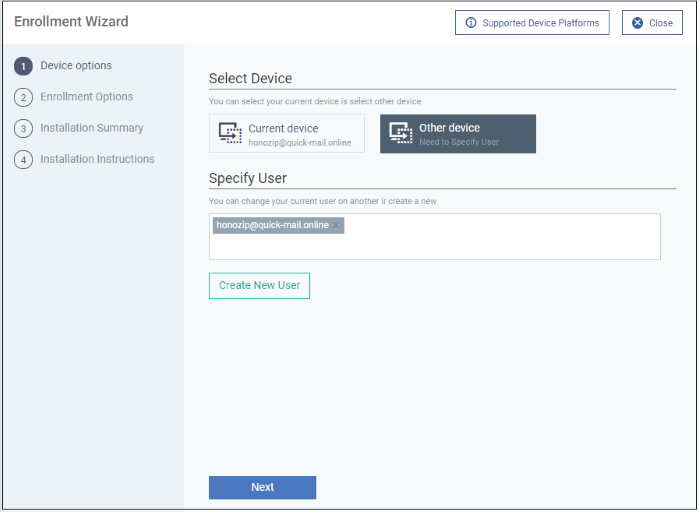
You can add additional, existing users by simply typing theiremail address in the box. Endpoint Manager will auto-suggest usersthat have already been created.
- Create New User - Click if you want
to add a new user to Endpoint Manager. You cannot add devicesunless you have first added the users that own them. The add-userprocess is explained here.
- Click 'Next' to proceed to step 2.
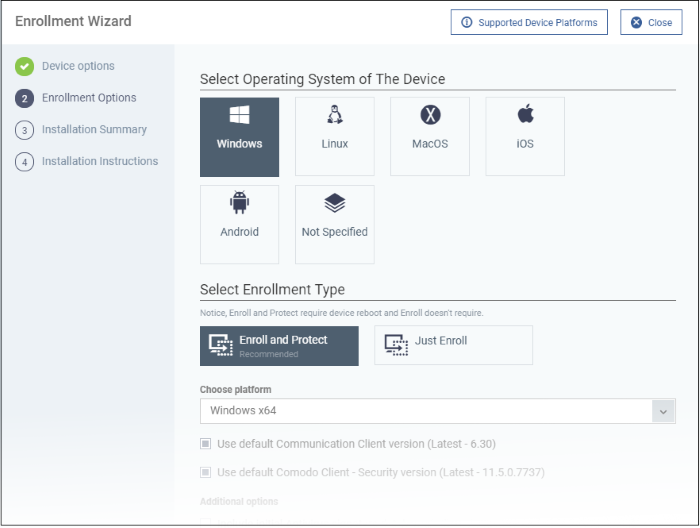
TLDR -
- Click ‘Not Specified’ if you only want to install the communication client on target devices. The wizard will detect the target operating system and send the appropriate client to the device user.
- Click one of the operating system tiles if you also want to install the security client. Make sure the target devices use the operating system you selected.
There are two broad ways you can enroll devices:
Option 1 – Enroll + Protect - Single Operating System
Click one of the operating system boxes to enroll devices of that type. Please make sure all your target devices use this operating system.
- The wizard will send enrollment mails that only provision the OS you chose.
- After choosing the OS, you can customize enrollment options as required. You can configure items such as enrollment type, reboot policy, client version, configuration profile and device name.
Option 2 - Enroll Only - Multiple Operating Systems
Click the ‘Not Specified’ box. This option installs onlythe communication client, and doesn’t install the security client.
Your target devices can be a mix of operating systems rather than a single OS. This option auto-detects the OS of the device andemails the appropriate client link to the user.
The latest version of the communication client is installed oneach device . The MDM profile is installed on MAC devices
- Note – You can use this option to quickly connect devices to Endpoint Manager, then go back later and install the security client
if required .
Enrollment Type
Applies to Windows, Mac
Enroll and Protect – Installsboth the communication client and the security client.
- Just Enroll – Installs only the communication client
Background. There are two types of client:
- Communication Client –
Connects the device to Endpoint Manager for central management. Itis mandatory to install this client.
- Security Client –
This is the security software. Depending on the operating system,it includes antivirus, firewall, threat-containment, web-filtering,and more . It is optional to install this client.
Click 'Next' to skip to step 3 if you are happy with your choices on this page.
OR
Use the following links to read more about the various settings per OS:
|
Setting |
Description |
|---|---|
|
Choose platform |
Select
|
|
Use default Communication Client version |
This client enrolls the endpoint for central management.
|
|
Use default Communication Client Security version |
This client installs security software such as antivirus, firewall and auto-containment.
|
|
Additional options |
AV Database - Choose whether to include the latest virus database with the installation package. This increases the size of the package. If disabled, the |
|
Configuration Profile |
A configuration profile is a collection of settings which specify a device's network access rights, security settings, antivirus scan schedule, and more. The default is 'Windows - Security Level 1' profile. Choose a different profile if required.
|
|
Set Reboot Options |
Endpoints need to be restarted to complete CCS installation. You have the following restart options:
|
|
Device Name Options |
|
- Click 'Next' to proceed to step 3
|
Setting |
Description |
|---|---|
|
Choose platform |
Select Linux OS version
|
|
Device Name Options |
|
- Click 'Next' to proceed to step 3
|
Setting |
Description |
|---|---|
|
Select Method |
|
|
Device Name Options |
|
- Click 'Next' to proceed to step 3
Click 'Next' to proceed to step 3.
- Do Not Change - The device’s existing name
is used as the device label inEndpoint Manager.
- Change - Enter a new device name. Note – You can restore the
original name from the device list screenif required
Review your choices so far.
The summary you see depends on the operating system and enrollment type:

- Click ‘Back’ or 'Change Configuration' (top-right) to revise
your choices .
- Click 'Next' to proceed to step 4
Step 4 - Installation Instructions
The final step is to send out the enrollment emails to the device owners:
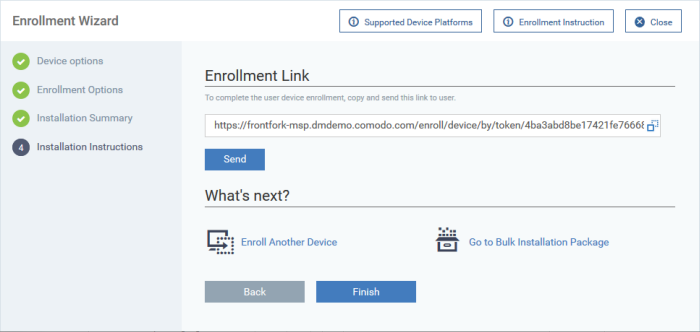
- Send – Click this to send enrollment mails to users with the settings you choose in steps 1, 2 and 3.

- Enroll Another Device – Takes you back to step 1
Go to Bulk Installation Package – Takes you to bulk installation package screen to configureand enroll users in bulk. See 'Bulk Enrollment of Devices'
- Click 'Finish' to close the window.
Note – If you chose 'Current Device' in step 1, then you can enroll your device in two ways:
1. Download the client in the final step.
Follow the instructions and complete the enrollment procedure.
2. Click 'Enrollment Instructions' at top-right, click the
appropriate enrollment link to your device and complete the procedure.
An
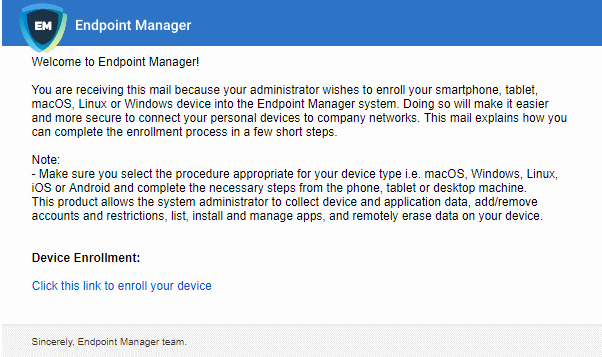
- Clicking the link will take the user to a page which lets them download the appropriate communication client/profile:
- Click 'Users' > 'User List' > click the name of a user to open their details screen > click 'Enroll Device'
- Click 'Devices' > 'Device List' > 'Enroll Device'
Enroll devices
- The user should open the mail on the device itself and click the device enrollment link.
- This starts a wizard which lets them download the appropriate client software for their device. An example is shown below:
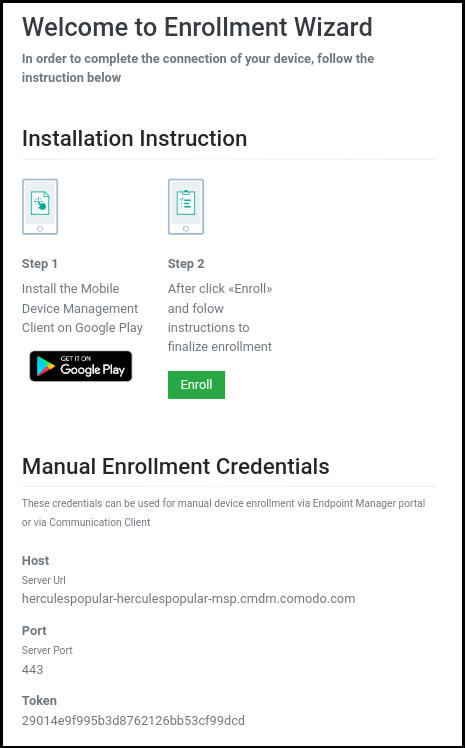
- Once installed, the client software will connect the device to Endpoint Manager.
- The following sections explain the enrollment process on different operating systems:
-
There are two steps to enroll Android devices:
Step 1 - Download and Install the communication client
- The user should open the mail on the device itself and open the device enrollment link.
- Next, tap 'Get it on Google Play' to download and install the client software.
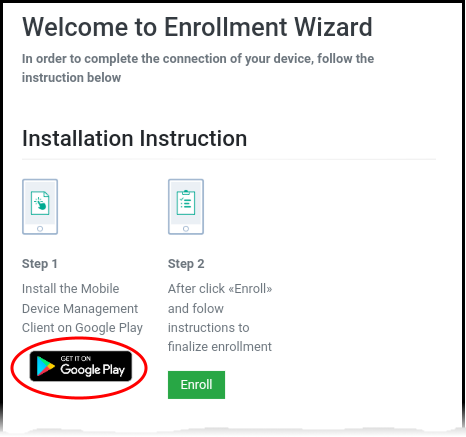
- After installation in step 1, the user should go back to the device enrollment page and tap the 'Enroll' button under 'Step 2':
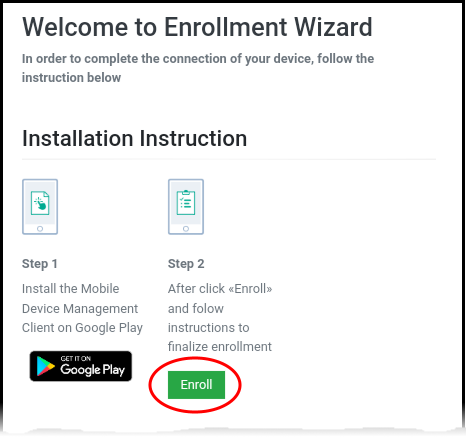
Next, the user has to tap 'Activate' to enroll the device.
Enroll iPhones, iPods and iPads
- Device owners should open the mail on the device itself and tap the enrollment link. This will take them to the device enrollment wizard.
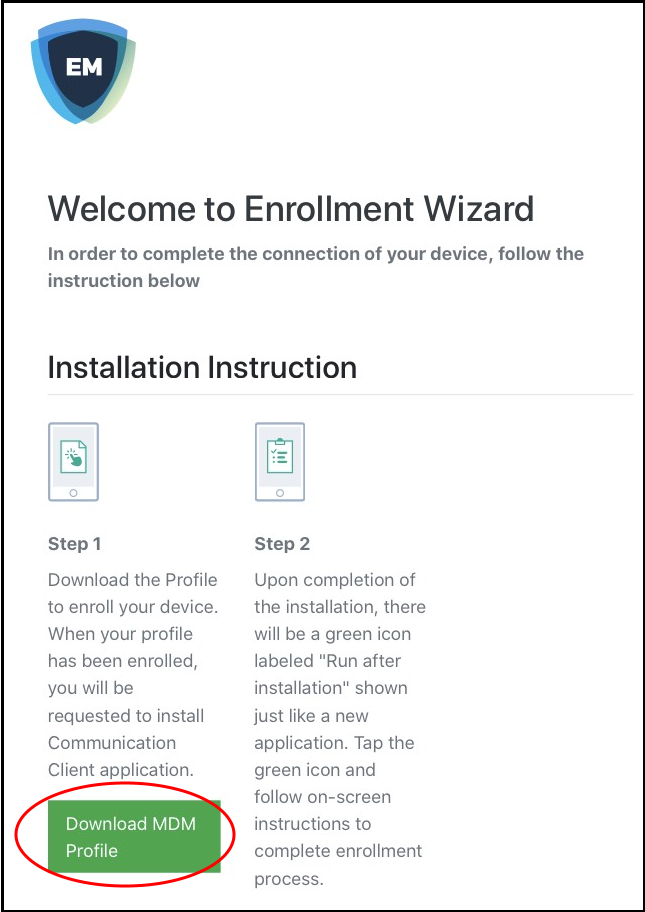
- Tap 'Download MDM Profile'
The 'Install Profile' wizard starts:
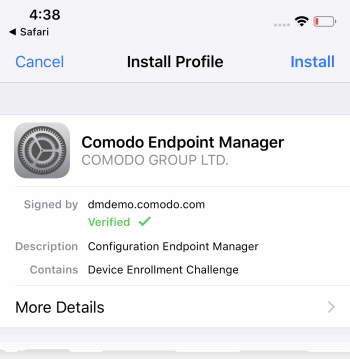
|
Note: Users must keep their device switched on at all times during enrollment. The enrollment process may fail if the device auto-locks or enters standby. |
- Tap 'Install' and follow the steps in the wizard.
- Then touch ‘Install’ at the app installation screen.
- The app is required to connect the device to Endpoint Manager:

- The app is downloaded from the Apple store using the user's account.
- After installation, tap the green 'Run After Install' icon on the home screen:
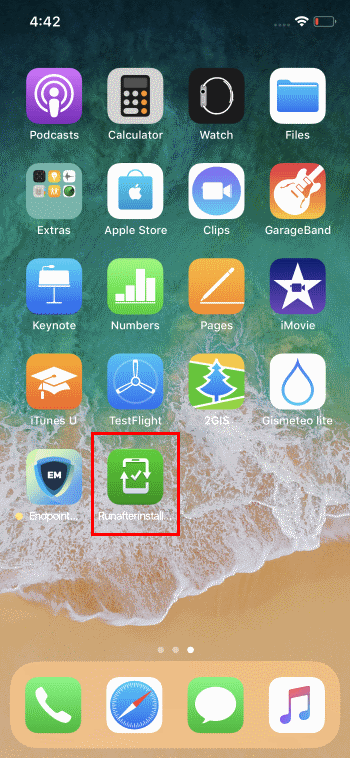
The device will be enrolled and connected to EM.
- Users should open the mail on the device itself and open the device enrollment link
- The following wizard opens:
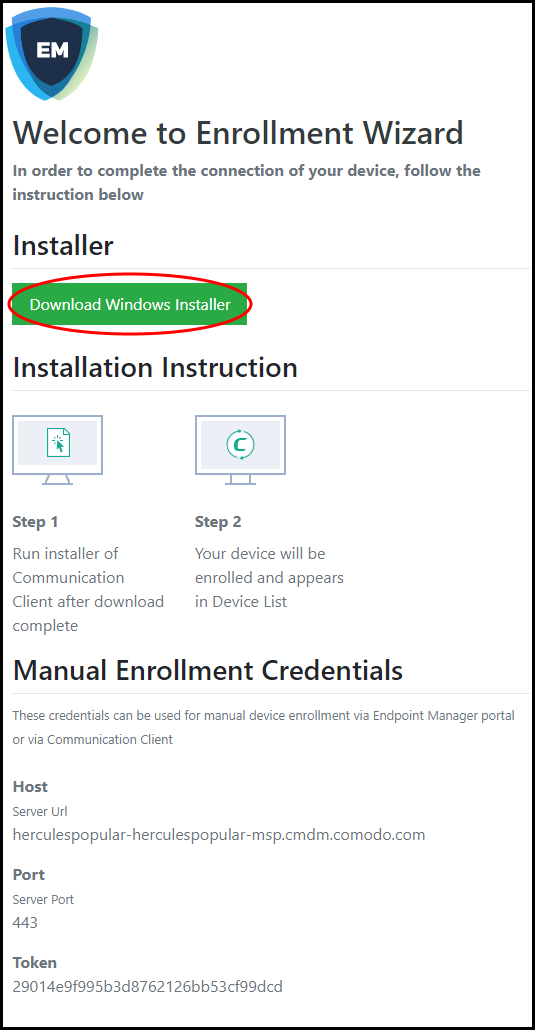
- Click the 'Download Windows Installer' button.
- The EM client setup file gets downloaded.
- Double-click on the file to install the communication client.
The device automatically gets added to Endpoint Manager once installation is complete. Comodo Client Security is installed if you chose it in the setup wizard. You also have the option to install CCS manually after device enrollment.
The client icon  appears at the
bottom-right of the endpoint screen.
appears at the
bottom-right of the endpoint screen.
- You can check whether the devices are successfully enrolled from the 'Devices' > 'Device List' interface.

- Users should open the mail on the device itself and open the device enrollment link
- The device enrollment wizard starts:
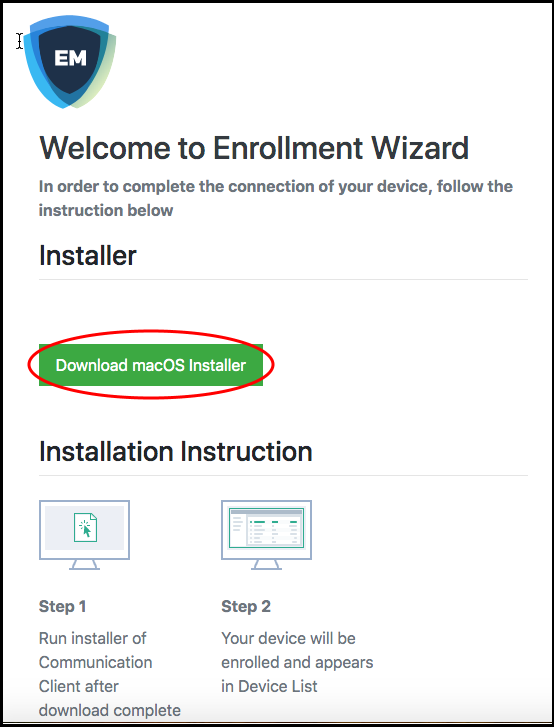
- Click 'Download mac OS Installer' in the wizard and save the setup file
- Open the setup file to install the communication client.
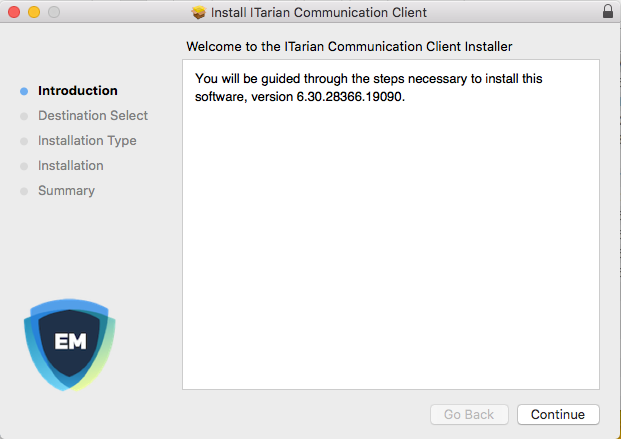
- Follow the wizard to complete the installation.
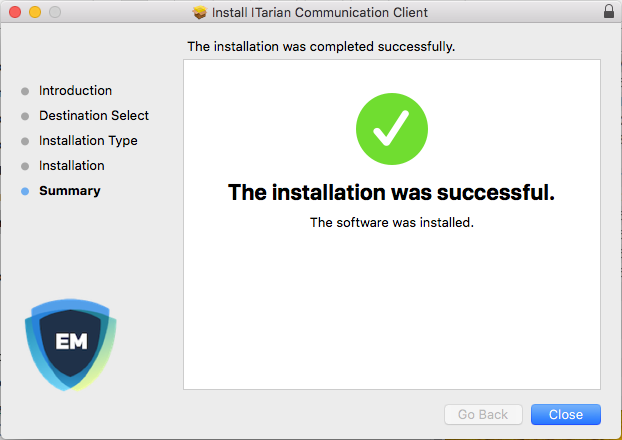
- The profiles screen will show you details of the Endpoint Manager profile, if you have chosen to install it.

- The device is automatically added to Endpoint Manager once installation is complete. CCS is installed if you included it in the setup wizard.
- Users should open the mail on the device itself and open the device enrollment link
- The device enrollment wizard starts:
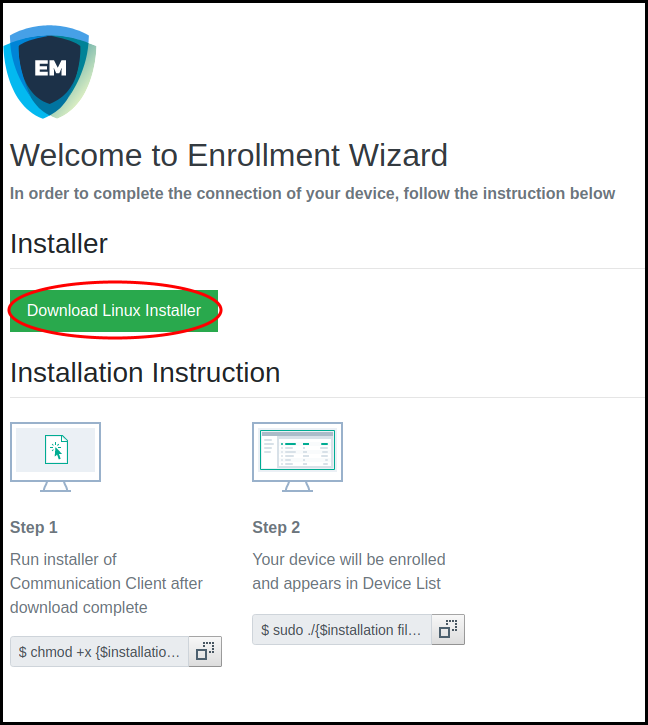
- Click the 'Download Linux Installer' button and save the file:
The communication client can be installed the device by completing the following:
-
Change installer mode to executable - enter the following command:
$ chmod +x {$installation file$}
-
Run installer with root privileges - enter the following command:
$ sudo ./{$installation file$}
For example:
chmod +x itsm_cTjIw6gG_installer.run
sudo./itsm_cTjIw6gG_installer.run
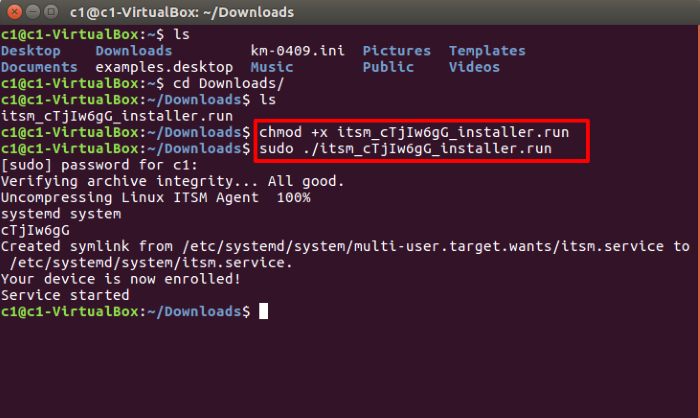
- The device is automatically added to Endpoint Manager once installation is complete. CCS is installed if you included it in the setup wizard.



